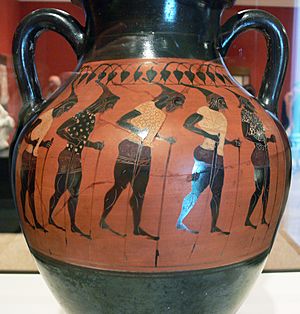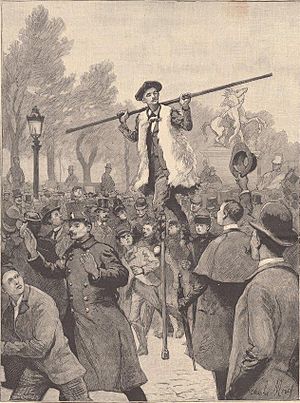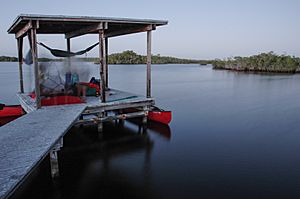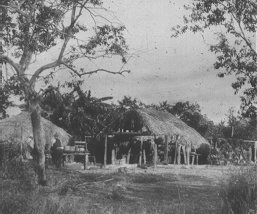Stilts facts for kids
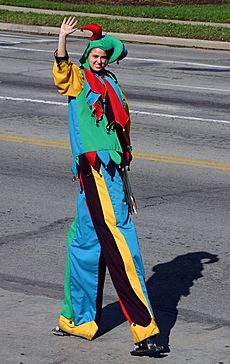
Stilts are poles, posts or pillars used to allow a person or structure to stand at a height above the ground. Stilts for walking are poles equipped with platforms for the feet to stand on and can be used, depending on the design, with straps to attach them to the user's legs or be held in place by the hands of the user.
In flood plains, and on beaches or unstable ground, buildings are often constructed on stilts to protect them from damage by water, waves or shifting soil or sand. Stilts have been used for many hundreds of years.
Contents
History of stiltwalking
Archaeological ruins and texts show that stilt-walking was practised in ancient Greece as far back as the 6th century BC. Some stilt use traditions are very old. In Belgium, stilt walkers of Namur have practiced fights on stilts since 1411.
The inhabitants of marshy or flooded areas sometimes use stilts for practical purposes, such as working in swamps or rivers.
The shepherds of the Landes region of southern France used to watch their flocks while standing on stilts to extend their field of vision, while townspeople often used them to travel the soggy ground in their everyday activities.
Modern uses
Stilts are available to be purchased as a children's skill toy and stilt skills are commonly taught in circus workshops at schools and summer fairs and other events. They are used widely in many countries for the purpose of entertainment. Stilt walkers perform their skills in parades, festivals and street events.
Early stilt walking acts were mostly of the style of a very tall person with the costume having long trousers or skirt to cover the stilts. More recently stilt walkers have created a wide variety of costumes that do not resemble a tall person. Examples are flowers and animals. One of the most recent varieties of stilt walking acts is a stilt walker riding a 'stilt bicycle'. This bicycle is usually an ordinary bicycle with extended seat post and handlebar stem.
Aluminium stilts are commonly used by fruit farmers in California to prune and harvest their peach, plum, and apricot trees. Stilts have been used for the washing of large windows, the repairing of thatched roofs, and the installation or painting of high ceilings. Stilts are used for drywall construction, finish painting, and hanging suspended ceiling tiles.
Types of stilts
Stilts can be used for various purposes: as a prop in entertainment, as a tool to enable other types of work to be achieved and as part of a hobby or recreation.
- Hand-held stilts: are used as childhood toys and in circus skills workshops and are of two main types: string and can/bucket stilts and pole stilts. Unlike other forms of stilts, hand-held stilts are not tied or strapped to the wearer.
- Peg stilts: also known as Chinese stilts, are commonly used by professional performers. These stilts strap on at the foot, ankle, and just below the knee. Peg stilts are often made from wood but can also be made of aluminium or tubular steel. This type of stilts are the most lightweight ones and allow a user to walk quickly, to turn suddenly, and even to jump rope or dance. The stilt walker must keep moving at all times to keep their balance.
- Drywall or Dura stilts: Drywall or Dura stilts are designed to allow the stilt walker to stand still or to walk. They were originally designed for people to work at an elevated height during drywall or plasterboard construction, painting and other such activities.
- Spring stilts: are spring-loaded stilts that allow the user to run, jump and perform various acrobatics. Spring stilts were patented in the United States in 2004 under the trademark "PowerSkip", marketed for recreational and extreme sports use.
- Digitigrade stilts: this stilt is a peg stilt whose line follows the foot and not the shin bone, this allows costumers to mimic some animals.
- Articulated stilts: are similar to drywall stilts in that they allow the stilt walker to stand in one place without shifting their weight from foot to foot. These stilts are commonly used in theme parks.
Stilt-walking records
- 1891 Sylvain Dornon (fr), a stilt-walker from the Landes region of France, walked from Paris to Moscow in 58 days.
- 1 October 2001 Saimaiti Yiming of China walked 79.6 km (49.5 mi) on 73 cm (29 in) stilts in 24 hours in Shanshan County, Xinjiang, China.
- 15 November 2006 Saimaiti Yiming of China took 10 steps on 16.41 m-high (53.8 ft) stilts to break the Guinness World Record for walking on the tallest stilts.
- 2008 Roy Maloy of Australia took 5 steps on stilts 17 m (56 ft) high, an unofficial record for the tallest stilts.
- 30 March 2008 Ashrita Furman of the US ran 1 mi (1.61 km) in 7 minutes 13 seconds on spring stilts in Dachau, Germany.
Chickee
Chikee or Chickee ("house" in the Creek and Mikasuki languages spoken by the Seminoles and Miccosukees) is a shelter supported by posts, with a raised floor, a thatched roof and open sides. Chickees are also known as chickee huts, stilt houses, or platform dwellings.
Chickees were used for cooking, sleeping, and eating.
Chickees continue to be used by Native American villages of the Miccosukee in the Everglades. Some upscale homes in southern Florida feature chickee-inspired buildings as garden or poolside structures. A few restaurants in Florida still use this exotic design to attract visitors.
Chickees are also used in backcountry areas of Everglades National Park including where mangroves or wetlands prevent camping on dry land. Made and maintained primarily for backcountry campers, these wooden structures stand several feet above the water and can usually accommodate four to five campers. These structures have portable restrooms. Some "double chickees" are linked by a walkway and can accommodate eight to ten people.
Chickees are very helpful, especially in the rain.
Images for kids
-
The Royal Merchtem Stilt Walkers
See also
 In Spanish: Zanco para niños
In Spanish: Zanco para niños


